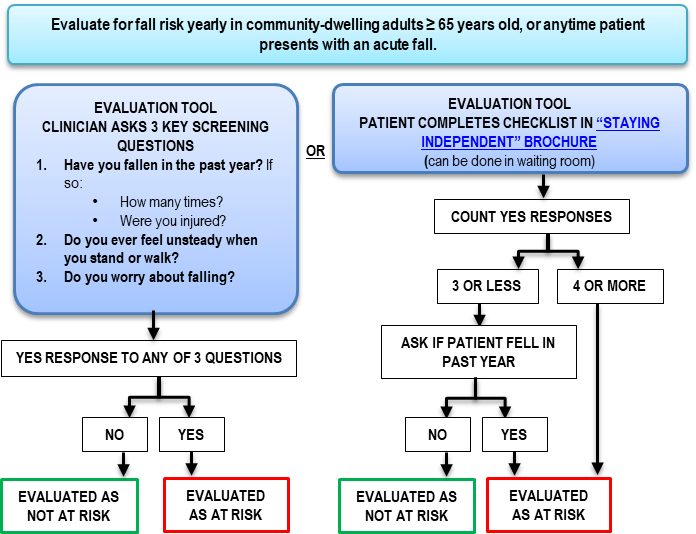9 Simple Techniques For Dementia Fall Risk
9 Simple Techniques For Dementia Fall Risk
Blog Article
Dementia Fall Risk Things To Know Before You Buy
Table of ContentsThe Main Principles Of Dementia Fall Risk The Buzz on Dementia Fall RiskDementia Fall Risk for Beginners5 Simple Techniques For Dementia Fall Risk
A loss danger assessment checks to see just how most likely it is that you will drop. It is primarily done for older grownups. The assessment generally includes: This includes a collection of questions regarding your overall health and wellness and if you have actually had previous falls or issues with equilibrium, standing, and/or walking. These devices evaluate your strength, equilibrium, and gait (the way you walk).STEADI consists of testing, assessing, and treatment. Interventions are suggestions that may reduce your threat of falling. STEADI consists of 3 actions: you for your threat of dropping for your risk variables that can be boosted to try to protect against drops (for instance, balance issues, damaged vision) to lower your threat of falling by utilizing effective approaches (for instance, providing education and learning and sources), you may be asked several concerns consisting of: Have you dropped in the past year? Do you really feel unsteady when standing or walking? Are you fretted about dropping?, your company will test your strength, equilibrium, and gait, using the following autumn evaluation devices: This examination checks your gait.
You'll sit down again. Your supplier will certainly inspect the length of time it takes you to do this. If it takes you 12 secs or more, it may mean you go to greater risk for an autumn. This test checks strength and equilibrium. You'll sit in a chair with your arms went across over your chest.
The positions will obtain more challenging as you go. Stand with your feet side-by-side. Move one foot midway forward, so the instep is touching the large toe of your other foot. Move one foot totally in front of the various other, so the toes are touching the heel of your other foot.
Things about Dementia Fall Risk
The majority of drops occur as an outcome of several adding aspects; therefore, managing the threat of dropping begins with recognizing the aspects that add to fall danger - Dementia Fall Risk. Several of the most pertinent risk elements include: Background of prior fallsChronic medical conditionsAcute illnessImpaired stride and equilibrium, reduced extremity weaknessCognitive impairmentChanges in visionCertain risky medicines and polypharmacyEnvironmental variables can also raise the risk for drops, consisting of: Inadequate lightingUneven or damaged flooringWet or unsafe floorsMissing or damaged handrails and get hold of barsDamaged or poorly fitted equipment, such as beds, wheelchairs, or walkersImproper usage of assistive devicesInadequate guidance of the individuals residing in the NF, consisting of those that display aggressive behaviorsA successful autumn danger management program calls for a comprehensive scientific evaluation, with input from all members of the interdisciplinary team

The care strategy must also include treatments that are system-based, such as those that promote a risk-free setting (proper go to my blog lights, hand rails, get bars, etc). The performance of the interventions ought to be evaluated occasionally, and the treatment strategy revised as required to reflect changes in the fall risk assessment. Executing a loss threat monitoring system making use of evidence-based ideal method can minimize the prevalence of falls in the NF, while limiting the possibility for fall-related injuries.
The 15-Second Trick For Dementia Fall Risk
The AGS/BGS standard advises evaluating all adults matured 65 years and older for autumn risk yearly. This screening includes asking clients whether they have actually fallen 2 or more times in the past year or looked for clinical focus for a fall, or, if they have not fallen, whether they feel unstable when walking.
Individuals who have actually fallen once without injury must have their equilibrium and gait evaluated; those with gait or equilibrium abnormalities must receive additional assessment. A history of 1 fall without injury and without stride or equilibrium problems does not warrant additional evaluation past ongoing yearly autumn danger testing. Dementia Fall Risk. A loss danger analysis is needed as part of the Welcome to Medicare evaluation

More About Dementia Fall Risk
Documenting a drops history is one of the top quality indicators for autumn prevention and monitoring. A critical part of risk analysis is a medication evaluation. Several courses of medicines boost loss risk (Table 2). Psychoactive medications in particular are independent forecasters of falls. These medications tend to be sedating, change the sensorium, and hinder balance and gait.
Postural hypotension can typically be alleviated by reducing the dosage of blood pressurelowering medicines and/or stopping drugs that have orthostatic hypotension as an adverse effects. Use of above-the-knee support hose and sleeping with the head of the bed boosted might also reduce postural decreases in high blood pressure. The suggested elements of a fall-focused checkup are shown in Box 1.

A yank time greater than or equal to 12 secs suggests high fall danger. The 30-Second Chair Stand examination evaluates lower extremity stamina and equilibrium. Being incapable to stand up from a chair of knee elevation without using one's arms suggests enhanced fall risk. The 4-Stage Equilibrium test evaluates static equilibrium by having the person stand in 4 positions, each considerably extra tough.
Report this page